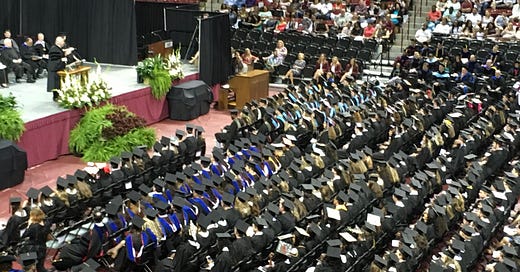Student-loan forgiveness fails to address the core problem
Instead of arguing about fairness and economic impact of debt cancellation, policy-makers should focus on common-sense compromises to reduce the cost of college
President Biden’s executive order last week canceling $10,000-$20,000 of student loan debt for borrowers with annual income of less than $125,000 drew the usual partisan responses. But this action and the subsequent reaction is different from most other issues. Much of what both sides say is correct – to some degree.
Yes, the loan forgiveness will remove barriers to success for the 43 million people who qualify for at least some relief. That could be a long-term plus for the economy.
But it’s also true that the timing is awkward at best. Even if forgiving $300 billion in debt doesn’t lead to higher inflation, the mere possibility could be another reason for the Federal Reserve Board to continue raising interest rates. Since most people with student loan debt also have other debt, the higher rates would offset part of the benefits. In particular, higher interest rates make housing more expensive. One of the arguments in favor of loan forgiveness was that it would allow young adults to buy homes.
Then, there’s the issue of fairness. As is usually the case with fairness debates, whether loan forgiveness is fair depends in part on how you define fair and in part on your personal circumstances. Those who repaid their loans, especially those who did so by forgoing purchases that people whose loans are forgiven made or will be able to make, are justified in thinking it isn’t fair. But those who say that student loan debt disproportionately affects those from low-income and disadvantaged backgrounds also are correct. Then there are those who did not go to college, many of whom see all who received federal student loans as benefiting from a government program at their expense.
While I see the arguments on all sides, I believe President Biden’s executive order was misguided for two reasons:
It is too broad, rather than targeting those most in need. Yes, there’s an income cap for qualifying for forgiveness, but it’s way too high. The annual income threshold of $125,000 for individuals and $250,000 for households excludes only about 5 percent of student loan recipients.
More importantly, this one-time action does nothing meaningful to address the core problem: the cost of college.
I will focus the rest of this column on the second objection.
As is typical with policy discussions today, most proposals for reducing the cost of college come from the partisan extremes. Those on the left push “free college” so no one will have to take out loans. Those on the right want to reduce, or even eliminate, the government’s role in funding loans and to a lesser degree higher education with the hope that colleges will be forced to lower tuition and fees to attract students.
Both those approaches have significant costs. The likelihood of passing legislation that would generate enough tax revenue to fund free college is remote. And the free-market model promoted by conservatives likely would do more to reduce the number of students than to shrink tuition costs.
But there are solutions, combining both conservative and progressive values, with a chance to work.
First, a proposal with appeal to conservatives: Reduce the number of loans. Borrowers should have to prove a likelihood that they can repay a loan. This is a bedrock financial principle. Anytime either the public or private sector – sometimes both in an unholy alliance – has decoupled loan approval from the ability to pay it has created problems. The example with the most relevance to student loans is subprime mortgages, which helped create the 2007-08 financial crisis. There are multiple ways to tether student loans to the ability to repay, considering factors such as the borrowers’ academic performance and earnings potential for their field of study.
Progressives will point out, correctly, that such a system would disproportionately affect students from low-income families and/or disadvantaged backgrounds. But instead of reducing loan standards, the government should expand the amount of Pell Grant money available to low-income students who show adequate academic potential. And grant money available for students in graduate programs that meet a vital public need – medicine and education, for example – should be significantly increased.
Borrowers should not bear the brunt of the responsibility for fixing the broken funding system for higher education. Colleges must lower costs. The government has various levers to encourage schools to do the right thing, starting with increased financial aid for programs that meet public needs. Another good option would be limiting the amount of money that students with loans and grants are allowed to spend on housing. This could help reverse the trend toward expensive, luxury dorms. Also, forbid the practice of requiring first-year students to live on campus, a practice that gives universities a captive market for their expensive housing. In addition, colleges should be required to meet student-retention and graduation-rate standards to be part of federal loan and grant programs.
There’s a theme to all these proposals: accountability. Students receiving taxpayer-backed loans should have to show they are making an effort to meet their academic responsibilities, so they’ll have the best chance possible to repay the loans. Colleges should be required to create an environment that gives all students the best possible chance to succeed. And politicians who use taxpayer money to “forgive” debt should first show that they are addressing the causes of the debt problem.
Mark Hester is a former business editor and editorial writer at The Oregonian.




